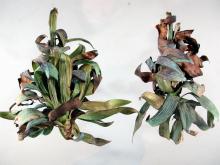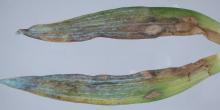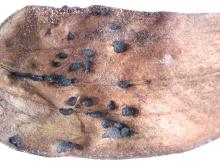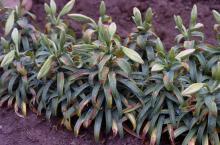Cause Botrytis elliptica and B. cinerea, fungi. The former has been reported on crocus, daylily, and gladiolus but is primarily on lily while the latter has a huge host range. Botrytis overwinters as sclerotia in the debris of plant shoots that mature and decay in fall. In spring, sclerotia on or near the soil surface produce conidia that infect leaves. Conidia are windblown to healthy foliage. Infection is most likely in wet foggy weather where plants are wet for 6 to 12 hours and when temperatures range from 50°F to 65°F during day or night. Infection by B. elliptica is through stomata on the underside of leaves. Spore production in diseased tissue spreads the fungus during the growing season. Under optimal conditions many spots may occur at once throughout the planting. Colonized flower parts that fall onto leaves or stems can be the source of mycelium that directly infects healthy tissues. Injuries due to hail can also favor disease development. The disease can reduce bulb growth as well as making cut flowers or pot grown plants unmarketable. Cultivars are known to differ in susceptibility.
Symptoms Typical initial symptoms are water-soaked (wet-looking), teardrop- or boat-shape brown spots that occur anywhere on the leaf. Spot color varies with leaf texture and the lily species affected, but usually the center is a different color and slightly sunken. Yellow streaks are often associated with these spots. As the spots increase in size the foliage is killed and hangs down. Disease severity is generally greatest on the lower leaves. Flowers develop tan-to-brown spreading spots on buds and petals. Dead tissue may be covered with the fuzzy gray growth and sporulation of the fungus during moist periods.
Cultural control
- Remove all plant debris at season's end. Preferably, pull shoots as soon as they can be pulled away easily from bulbs.
- Removing flower buds early helps manage disease.
- Annual digging.
- Reduce planting densities to promote good air circulation.
- Avoid overhead irrigation or any practice that keeps plants wet for extended periods of time. Individual drip watering of pots can also help.
- Rotate planting sites to new ground each year.
- In the greenhouse, maintain a steady, relatively dry environment by keeping greenhouse humidity below 90%, increasing spacing between plants for good air circulation, and taking care not to splash water on foliage during watering. Heating the greenhouse at night (especially for zero or negative DIF) or venting around sunset may be necessary. Heating in the morning before sunup can also help prevent dew formation as air temperature increases faster than the temperature of plant parts. If using DROP or DIP for size control, do not let humidity rise above 90%.
Chemical control Best used with cultural controls. Spray at the first signs of infection. Fungicide coverage of the lower leaf surface is important to obtain the best disease control. Alternate or tank-mix products from different groups with different modes of activity to prevent developing resistant fungi. Limit the use of any one group during crop production. Disease warning systems have been developed to time fungicide applications.
- Astun at 10 to 17 fl oz/100 gal water. Group 7 fungicide. 12-hr reentry.
- Bonide Fung-onil Multi-purpose Fungicide at 2.25 teaspoons/gal water. H
- Bordeaux mixture at 10-10-100. Group M1 fungicide. O
- Chipco 26019 FLO at 1 to 2.5 quarts/100 gal water plus a resin-based surfactant. Group 2 fungicide. 12-hr reentry.
- C-O-C-S WDG at 2 to 4.9 lb/A. Group M1 fungicide. 48-hr reentry.
- CuPRO 5000 at 4.5 to 6.25 lb/A. Group M1 fungicide. 48-hr reentry.
- Daconil Weather Stik at 1.38 pints/100 gal water. Group M5 fungicide. 12-hr reentry.
- Decree 50 WDG at 0.75 to 1.5 lb/100 gal water. Has not worked well on the south Oregon coast. Group 17 fungicide. 12-hr reentry.
- Junction at 4 to 6.5 lb/20 to 100 gal water/A. Group M1 + M3 fungicide. 48-hr reentry.
- Medallion WDG at 2 to 4 oz/100 gal water. Use with oils or adjuvants may cause plant damage. Group 12 fungicide. 12-hr reentry.
- Mancozeb-based products can be used as mixing partners and provide some protection. Group M3 fungicides. 24-hr reentry.
- Fore 80 WP at 1.5 lb/100 gal water plus a spreader-sticker.
- Protect DF at 1 to 2 lb/100 gal water plus 2 to 4 oz spreader-sticker.
- Mural at 4 to 7 oz/100 gal water. Group 7 + 11 fungicide. 12-hr reentry.
- Nu-Cop 50 DF at 2 to 5 lb/100 gal water. Group M1 fungicide. 48-hr reentry.
- Orkestra at 8 fl oz/100 gal water. Group 7 + 11 fungicide. 12-hr reentry.
- Pageant at 12 to 18 oz/100 gal water. Do not use with organosilicone-based adjuvants. Group 7 + 11 fungicide. 12-hr reentry.
- Palladium at 4 to 6 oz/100 gal water. Avoid excessive runoff to small plants, which may result in stunting and/or chlorosis. Group 9 + 12 fungicide. 12-hr reentry.
- Scala SC at 18 fl oz/A alone or 9 to 18 fl oz/A in a tank-mix. Group 9 fungicide. 12-hr reentry.
- Spectro 90 WDG at 1 to 2 lb/100 gal water. Group 1 + M5 fungicide. 12-hr reentry.
- Spirato GHN at 2 to 4 fl oz/100 gal water. Use with oils or adjuvants may cause plant damage. Group 12 fungicide. 12-hr reentry.
Biological control
- Actinovate AG (Streptomyces lydicus strain WYEC 108) at 3 to 12 oz/A plus a spreader-sticker. Do not mix with Regalia or certain copper or sulfur-based products. 4-hr reentry. O
- LALStop G46 WG (Clonostachys rosea [formerly Gliocladium catenulatum] strain J1446) at 0.13 oz/1 gal water. Do not use with other products in the tank. 4-hr reentry. O
- RootShield Plus Granules (Trichoderma harzianum Rifai strain T-22 and T. virens strain G-41) at 1 to 3 lb/cubic yard soil mix. No restrictions on reentry required when soil incorporated. O
Reference Doss, R.P., Chastagner, G.A., and Riley, K.L. 1988. Streaking of lily leaves associated with infection by Botrytis elliptica. Plant Disease 72:859-861.





